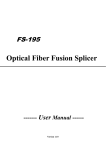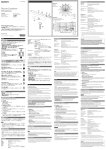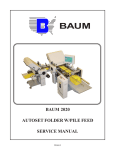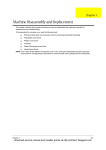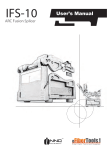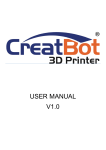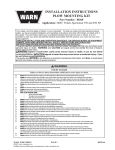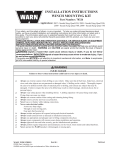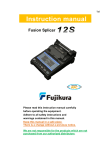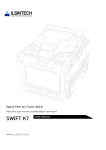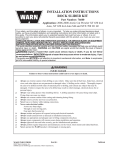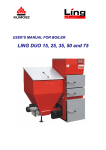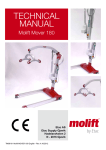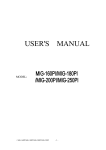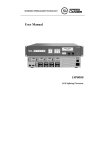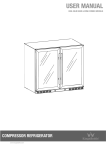Download 操 作 手 册 - redcam.pl
Transcript
Optical Fiber Fusion Splicer User Manual Please read this user manual carefully before the use of products Version 1.10 Warning Warning:: Ignore the warning, non-proper use of fusion splicer could lead to fatal nd serious inju injuryy. 1. The input voltage of this model of machine is definite; please do not use the voltage outside the scope. Please use the correct AC and DC power supply. 2. When the fusion splicer comes across the following failures, please immediately remove the AC power cord from the power supply input and turn off the fusion splicer, otherwise will lead to the incapable of the repairing and even will cause personal injury, death and fire. ★ Smoke, smell, noise or heat anomaly ★ Broken or damaged machines ★ Liquid or foreign matter enters the interior of the machine 3. This model of fusion splicer does not have the need to maintain internal components, dismantling of fusion splicer and power modules is prohibited; any mistake in maintenance will lead to the machine beyond repair even causing bodily harm. 4. The machine has strictly limitation to the power supply module used. 5. The fusion splicer is prohibited to be used under the environment with the inflammable liquid or flammable gas; otherwise will lead to fire, explosion and other serious consequences. ● Disclaimer Clause The Company does not assume any liability for all damage caused by the use of non original battery battery.. ● To avoid possible misoperation or insecurity ,a valid ground three-hole socket must be used when AC/DC adaptor access to AC 220V 50HZ power. Notes: 1.The fusion splicer is used for the fusion of quartz glass fiber; please do not use this machine for other usages. Please read this manual carefully before using. 2.Please do not deposit fusion splicer under the environment with high temperature or humidity. 3.If the fusion splicer is used in the environment with lots of dust, it should avoid dust as far as possible. 4.When the fusion splicer moves from the low-temperature environment to high-temperature environment, heating process must be ensured as possible to eliminate condensation. 5.In order to maintain machine’s performance, recommend to do complete machine maintenance once a year. 6.The fusion splicer has been precision calibrated, please try to avoid strong vibration, and impact, and use dedicated box for transportation and storage. ● The fusion splicer must be repaired and debugged by specialized technical for the appeared problems, please contact the manufacturers in a timely manner. 1 Brief Introduction .................................................................................................. ..................................................................................................11 1.1 Technical Indicators of the Product.........................................................................................................................1 1.2 Configuration of fusion splicer............................................................................................................................... 2 1.3 Parts Name of fusion splicer....................................................................................................................................3 1.4 Descriptions of the Keyboard of the Fusion Splicer................................................................................................4 1.5 Description of the standby interface of the Fusion Splicer………………………………………………………..6 2 Basic operation........................................................................................................7 2.1 Descriptions of the power modules......................................................................................................................... 7 2.2 AC operation.............................................................................................................................................................8 2.3 Battery supply operation ..........................................................................................................................................8 2.3.1 Checking of battery capacity.............................................................................................................................. 8 2.3.2 Battery charging ................................................................................................................................................10 2.3.3 Under Voltage Alarm ........................................................................................................................................10 2.3.4 The other considerations ....................................................................................................................................11 2.4 Turn on and turn off................................................................................................................................................12 2.5 Display brightness control.......................................................................................................................................13 2.6 Cover fiber pyrocondensation tude..........................................................................................................................13 2.7 Preparation of fiber end-face...................................................................................................................................14 2.8 Place fiber................................................................................................................................................................15 3 Management Menu................................................................................................16 3.1 Overview of First-degree Menus.............................................................................................................................16 3.2 Splice Mode Menu...................................................................................................................................................17 3.2.1 Overview.............................................................................................................................................................17 3.2.2 [Select And Edit Splice Mode]...........................................................................................................................18 3.2.3 [Select And Edit Heater Mode]...........................................................................................................................24 3.2.4 [Arc Calibration]..................................................................................................................................................27 3.2.5 [Operation Options].............................................................................................................................................29 3.2.6 [Splice Memory] menu.....................................................................................................................................32 3.3 Utility Menu.............................................................................................................................................................36 3.3.1 Descriptions for menu options...........................................................................................................................36 3.3.2 Change parameters............................................................................................................................................37 3..4 Help menu................................................................................................................................................................37 4 senior settings.........................................................................................................38 4.1 Slecting/editing the splice mode………..…………………………………………………………………………38 4.1.1 select splice mode according to optical fiber types.............................................................................................38 4.1.2 Referring or editing splice mode.........................................................................................................................40 4.2 Creating splice mode..................................................................................................................................................44 4.2.1 Default splice mode...............................................................................................................................................44 4.2.2 Add or copy splice modes......................................................................................................................................44 4.3 Fusion operation.........................................................................................................................................................47 4.3.1 checking of fiber cutting angle and fiber end face.................................................................................................48 . 4.3.2 Auto calibration and splic ...................................................................................................................................49 4.3.3 Splice loss estimation............................................................................................................................................49 4.4 Tension test ................................................................................................................................................................51 4.5 Storing splicing results .............................................................................................................................................52 4.6 reinforce the fusion point...........................................................................................................................................52 4.7 Manually move the motor..........................................................................................................................................53 4.8 Application of Soft Keyboard....................................................................................................................................55 5 Check and Maintenance..........................................................................................57 5.1 Cleaning V-grooves...................................................................................................................................................57 5.2 Cleaning Fiber Clamp Chips......................................................................................................................................58 5.3 Cleaning wind protector mirrors................................................................................................................................58 5.4 Cleaning objective lenses............................................................................................................................................59 5.5 Replace electrodes......................................................................................................................................................60 5.6 Stabilizing electrodes..................................................................................................................................................61 5.7 Clearing arc count.......................................................................................................................................................62 5.8 Maintenance of cleaver...............................................................................................................................................62 5.9 Set Calendar................................................................................................................................................................64 5.10 Change the spare lithium battery pack......................................................................................................................64 6 Questions and troubleshooting.............................................................................66 6.1 Power supply..............................................................................................................................................................66 6.2 Splicing operation......................................................................................................................................................66 6.3 Heating operation.......................................................................................................................................................68 6.4 Other fuctions.............................................................................................................................................................68 ……………… .........................................69 Addenda A Summary of quick operating operating……………… ……………….........................................69 Addenda B Guarantee period and limits.................................................................71 1. Brief Introduction Thank you for buying the product. The manual detailed introduces the performance and usage of automatic fiber fusion splicer. The splicer uses high-speed image processing technology and special precision positioning technology, which can make the entire process of fiber splicing in nine seconds automatically. Large-screen LCD monitors make all stages of fiber splicing clear. It is small in shape, light in weight, which is suitable for field work. Its operation is simple, fusion speed is high, fusion loss is small, so it is particularly applicable to Optical Fiber Communication engineering and maintenance of communication fields such as telecommunications, broadcasting, railways, petrochemical, power supply, the armed forces, public security and other areas, and the teaching and research of research institutes. In order to complete fusion operation more accurately, please read this manual in detail. 1.1 Technical Indicators of the Product Applicable optical fiber SM(G.652 & G.657)、MM(G.651)、DS(G.653)、 NZDS(G.655) and user-defined optical fiber Splice loss 0.02dB (SM)、 0.01dB (MM) Return loss Better than 60dB Typical splicing time 9 seconds (standard SM) Typical heating time 35 seconds (the heating time can be set and the temperature of the heater can be adjusted) Optical fiber alignment Fine alignment, core alignment and cladding alignment Diameter of optical fiber Diameter of cladding 80~150μm, diameter of coating 100~1000μm Cut length Coating of 250μm below: 10~16 mm; coating of 250~1000μm: 16 mm Hot hrinkable bush 60 mm bush 0.04dB (DS⁄NZDS) 1 Tension force test Standard 2N (optional) Magnification Horizontal double display, 300 times; vertical double display, 150 times Display 5.7 inch TFT color LCD display Splicing method 53 groups for factory mode and 40 groups for user mode Heating method 9 groups for factory mode and 24 groups for user mode Save of the splice loss Latest 4,000 splicing results will be saved in the built-in memory. External interface USB interface, convenient for data download and software update VGA Interface, can link PC and LCD TV Built-in battery Can be used for more than 160 times of continuous splicing and heating Power supply Built-in lithium battery 11.1V; External adapter, input: AC100-240V 50HZ, output DC13.5V/5A Working environment Temperature: -10~+50℃, humidity: <95%RH (no condensation) Working elevation: 0~5000m, maximum wind speed: 15m/s Save environment Temperature: -40~60℃, save humidity: 0~95% Physical dimension 150mm(length)×150mm(width)×135mm(height) Weight 3.13Kg (including battery) 1.2 Configuration of fusion splicer Following is the standard configurations of fiber splicing: No. Name Quantity Remark 1 fusion splicer 1 host 2 carrying case 1 Accessories 3 spare electrode 1 Accessories 4 Power adapter 1 Accessories 5 AC power cord 1 Accessories 6 plastic tweezer 1 Accessories 7 cleaning brush 1 Accessories 2 8 cooling tray 1 Accessories 9 monitors shield 1 Accessories 10 Usage Manual 1 Annex 1.3 Parts Name of fusion splicer Wind resistance cover Heater Power switch VGA interface Key board LCD USB interface Power module 3 Heater V shaped slot 电极罩 fiber clip Electrode strip 电极棒 Electrode Night light 防风罩 Power switch 防风罩磁铁 Magnet of wind resistance cover Presser foot of fiber Wind resistance cover 1. 4 Descriptions of the Keyboard of the Fusion Splicer Membrane figure of left and right keyboards 4 Keyboard Mode of manual Mode of automatic operation operation Power switch Power switch Power switch To increase the The optical fiber moves brightness of the display upward Standby mode To reduce the brightness The optical fiber moves of the display downward The optical fiber moves Invalid left Turn on the help screen The optical fiber moves right Invalid Invalid Invalid Invalid Mode of parameter menu Power switch Increase the parameter quantum or move the cursor Increase the parameter quantum or move the cursor Increase the parameter quantum or move the cursor Increase the parameter quantum or move the cursor To enter the menu To switch on the manual mode driver at pausing state To enter “select splice To enter the “select parameter files files”” menu parameter files files”” menu Invalid Invalid Invalid Exit from the current menu screen Heater switch Heater switch Heater switch Heater switch Reset of motor Reset of motor Reset of motor Invalid Invalid Invalid Invalid Invalid Switch X/Y display screen Invalid Start to fusion Further propulsion/start fusion Discharging Discharging Switch X/Y display Switch X/Y display screen screen Invalid Invalid →edit the fusion(heating) Select Select→ parameter files To enter the next menu interface/ confirm the modifier ● To define the mode of manual operation(Editing Splice Management Select) 1. Set <Pause 1> to "ON" at the Operation Option; 2. Set <Pause 2> to "ON" at the Operation Option. 3. Press at the interface of [Pause 2], align the optical fiber left and 5 right with the best gapping space by driving the motor through or and , and then press and to enable the fusion splicer to directly discharge and start splicing,and display the estimate loss. 1. 5 Descriptions of the standby interface of the Fusion Splicer The current working interface of the Fusion Splicer The current Splice Mode The current Heater Mode The current power source of the Fusion Splicer Keyboard operation help for the current working interface LCD Monitor Fusion splicer is equipped with a liquid crystal display, it is a sophisticated accessory produced in the strictly quality control factory environment. Nevertheless, there will be some black, red, blue, and green dots on the screen. According to the difference of screen watching perspective, the brightness of the display will be different. These symptoms are not a deficiency of LCD monitor, and it is a natural phenomenon. 6 2. Basic operation Fusion splicer is designed for the fusion of many types of fiber by using core diameter aiming rationale, its shape is compact, light weight, which is suitable for field work.Operation is simple, fusion speed is high, and fusion loss is small. 2.11 Descriptions of the power modules Fusion Splicer uses 2 in 1 power module design, during the work, the Fusion Splicer can be supplied by the polymer lithium ion battery separately; or use AC adapter for electricity supply; when adapter is used for electricity supply, the polymer lithium ion battery is charged at the same time. The lithium battery to be changed must be the model specified by the Company. ● Disclaimer Clause : The Company does not assumeany liabilityfor all damage caused by the use of non original battery battery.. 7 ● To avoid possible misoperation orinsecurity ,a valid ground three-hole socket must be used when AC/DC adaptor access to AC 220V 50H power. 2.22 AC operation 2.2.1 When AC power supply is adopted, the AC/DC adapter supplied by the company should be used. The basic parameters of the adapter are as follows: INPUT: AC100-240V~1.8A 50/60HZ OUTPUT: DC13.5V ⁄ 5A 2.2.2 The AC/DC adapter will not be able to supple normal DC output if the input AC voltage is lower than 100V or higher than 240V. At this situation , the DC output line of the adapter must not be inserted into “POWER INPUT “specified on the power module of the Fusion Splicer, otherwise it will results in the damage of fusion splicer. 2.2.3 If lithium battery is arranged in the battery case, the battery pack will also be charged when the adapter is supplying power. However, it is recommended that the Fusion Splicer be shut when charged. 2.33 Battery supply operation The user may choose to use the polymer lithium battery in the splicer to 8 separately supply for the Fusion Splicer. 2.3.1 Checking of battery capacity When the power module is not in the charged state, press the "PUSH" button on the flank of the power module. Then the four battery capacity indicator (red) lights on the left side will be bright. The number of the lit light represents the highness or lowness of the battery capacity. See the following table. When the power module is in the charged state, the four battery capacity indicator (red) lights on the left side will be bright, which only represents the highness of the current charge voltage, but the capacity of the battery. The capcity level of battery is as follows: (when presses the Push beside the power module): 9 Battery capciy ≥80% Battery capciy ≥60% Battery capciy capciy≥40% Battery capciy capciy≥15% Battery capciy capciy≤10% Battery Voltage 12.2V Battery Voltage 11.8V Battery Voltage 11.4V Battery Voltage 11V 11V Battery Voltage <11V ● The lights are on О The lights are off Notes: the capacity of the built-in polymer lithium battery of the power module: 11.1V. 2.3.2 Battery charging <1> Whether the battery capacity is in adequacy, every time the AC power adapter is inserted into “POWER INPUT “on the Fusion Splicer power module, the power module will start a charging process. <2> Display of charged state: During the charging, the charging indicator (CHARGE) light is red; after the charging completion, the charging indicator (CHARGE) will be green. <3> When the splicer is shut down, the maximum charging time is three hours 40 minutes, and the shortest is 40 minutes. The length of the charging time is dependent on the current battery capacity of the splicer. <4> If the splicer is charged when it is active, the charging time should be longer. The user is recommended to charge the battery when the splicer is shut down, thus the charging time will be shortened. 2.3.3 Under Voltage Alarm his model of fusion splicer has the function of “Under Voltage Alarm”. If the capacity of the lithium battery is lower than the specified value (the default value is around 10.3V), the splicer will automatically alarm and lock the keyboard to disable input. The user should press until the 10 Fusion Splicer is shut down, and charge the lithium battery pack as soon as possible, or use the adapter to supply power. See the following pictures. 2.3.4 The other considerations <1> For any fusion splicer not to be used for more than 1 month, it is suggested to separate the lithium battery and machine for saving. <2> The lithium battery should be charged in the environmental temperature ranging between 0℃~+40℃. <3> The battery, with certain service life, belongs to consumables. When the fusion splicer can only work for a short time despite the battery level of the lithium battery above 90%, please replace the battery. Please use the battery of the model designated by the Company for replacement. <4> Before the battery power supply for the fusion splicer, the battery level must be checked. If the battery is low or the low voltage warning is given, please recharge the lithium battery timely. <5> Please do not charge or discharge the battery in a low temperature for a long time to prevent the decrease of the battery life. Accidents may happen if charging or discharging the battery or special battery charger and battery in a high temperature. 11 <6>When charging the battery with the special battery charger, immediately disconnect the charger when the battery is fully charged. Huge damage may be incurred or accidents may occur on the lithium battery if the battery fully charged is still under the charging state. <7> The battery should be stored in a clean, dry and ventilated indoor environment of temperature ranging –5℃~+35℃ and humidity of 65±20%RH. <8> If the battery is stored for a long time, it should be charged with the special charger provided by the Company once every 90 days. The life of the battery may be extended if the battery is half fully charged in a long time. <9> It is prohibited to remove the battery without explicit approval or put it into fire, to prevent explosion of battery. 2.4 Turn on and turn off Turn on Press button on the operator panel until the LED indicator lights turn from green to red, release the button . When all of the motors return to the initial position, the screen shows the reset menu. 12 Turn off Press button on the operator panel until the LED indicator turn from red to green, realease the button , now the machine is turned off. 2.5 Display brightness control When the external environment is different, the user can adjust the display brightness for the convenience of the Fusion Splicer operation. Display brightness control should be done in the “standby” operation interface. <1> Press or in the “standby” operation interface to change the brightness of the display. <2> Press to confirm the brightness changes, and return to “standby” operation interface. ● When the display brightness is moderate, the capacity loss can be reduced, and the endurance of the battery can be prolonged. 2.6 Cover fiber pyrocondensation tude The installation of fiber pyrocondensation tude 13 2.7 Preparation of fiber end-face 2.7.1 Open the big and small clips of the cutter; push the sliding plate installed with blade from the end to the front. 2.7.2 Use fiber stripping pliers to strip fiber coating layer, the length of which is 30-40 mm. Use gauze dipping with alcohol or wadding soft enough to wipe clean the fiber. Wiping with a clean cotton cloth once, Notes: and do not clean it with the same cloth for the second time. (Notes: Please use the alcohol with purity more than 99%.) Fiber stripping Clean 2.7.3 Aim the edge of the fiber coating layer at the “16”calibration of the 14 cutter yardstick and put the fiber into orientation pressure tank with the left hand, and be sure that the bare fiber has been straightly put on the right and left rubber pads. 2.7.4 Close the small clip, big clip by right hand and promote sliding plate installed with blade to the other side, and then cut the fiber. 2.7.5 Hold the cutter by left hand and open the big clip by right hand and romove the fiber chips to put them in fixed containers. 2.7.6 Pinch and hold the fiber with the left hand, and open the small clip with the right hand at the same time, and carefully remove the fiber. ● Notes: the clean cross-section of fiber can not touch other things. 2.8 Place fiber 2.8.1 Open shielding cover and left and right fiber clips. 2.8.2 Put the good fiber end face in the V-shaped groove, ensure the tip of the fiber between the tip of the electrode and V-shaped groove’s edge. 15 ● If the fiber is bending, bending part should be upward when placing the fiber. ● To ensure the splice quality of the fiber, the clean cross-section of fiber can not touch other things. 2.8.3 Use fingers to pinch the fiber, and then close the left clip, and press the fiber. Ensure the fiber is placed in the bottom of V-shape groovy. If the fiber is placed incorrect, please replace the fiber. The fiber end face don’t touch the V-shape groove when place the fiber. 2.8.4 Place another optical fiber according to the above steps. 2.8.5 Close shielding cover. 3. Management Menu The details of managing the options of Fusion Splicer are described in this chapter. 3.1 Overview of Frist-degree Menus 3.1.1 Two Frist-degree Menus are arranged on the operation interface of Fusion Splicer, and a number of options are listed in each Frist-degree Menu. 3.1.2 Press at [standby] state of the current splice, heating modes or after completion of splice to enter “Splice Mode menu”; press or to switch between the two Frist-degree Menus; press to return to the previous operation interface of [standby]. Options of each Frist-degree Menu and their submenu will be described from Section 3.2 16 Two Frist-degree Menus are:: A. “Splice Mode Menu Menu”” B.““Application Menu Menu”” 3.1.3 In each menu, Press or and move the cursor up and down to choose the desired option, and press to enter; Press to return to the previous operation interface. 3.2 Splice Mode Menu 3.2.1 Overview “Splice Mode Menu “includes options which are closely related to the fusion splice ; it also includes the important parameters and options in the process of fusion splice. 17 Splice Mode Menu of the splicer includes the following options: A. [Select And Edit Splice Mode] B. [Select And Edit Heater Mode] C. [Arc calibration] D. [Operation Options] E. [Splice Memory] 3.2.2 [Select And Edit Splice Mode] <1> Select Splice Mode File Press in “Splice Mode menu” to select [Select And Edit Splice Mode], and press to enter, then a list of “Select Splice Mode File” is displayed. See the following pictures. The menu of “Select Splice Mode Files” The following items are displayed for each of the “Select Splice Mode Files” list: [No.]、 [File name]、 [Mode]、 [Fiber]。 <2> Editing the “Select Splice Mode Files” In the interface of “Select Splice Mode Files” list, press and move the cursor to a splice mode file with a certain number, and then press to enter the menu of “Edit Splice Mode Files”. See the following pictures. 18 <3> 2 or 3 interfaces are included in a menu of “Edit Splice Mode Files”; two displace interfaces can be opened by each setting of [Mode] (including Auto, Calibrate, Normal or Special); Press to switch between different interfaces; Press one by one to return to the previous operation interface. Notes: A. For splice mode files which is set to Auto or Calibrate [Mode], if first press and then press , then the menu of “Edit Splice Mode Files” can only switch between 2 screens; Press one by one to return to the previous operation interface. See the following pictures. 19 Parameter Description File name Title for a splice parameter file can be expressed in up to 15 characters. The title is displayed in the [Select Splice Mode Files] menu. Splice Mode The splicer has four options of Splice Mode: Auto, Calibrate, Normal, and Special, wherein the first three are common options. Fiber Type A list of splice modes stored in the splicer database is displayed. Upon inputting the appropriate mode, the selected splice mode stored in database area is copied to a selected splice mode in user-programmable area. Cleave Limit An error message is displayed if the cleave angle of either the left or right fiber ends exceed the selected threshold . Loss Limit An error message is displayed if the estimated splice loss exceeds the selected threshold . Arc power Under Auto/Calibrate fusion model, Arc power is fixed at 80bits. Arc time Under Auto/Calibrate fusion model, Arc time is fixed at 1500ms and cann’t amended. Cleaning Arc A cleaning arc burns out micro dust on the surface of the fiber with an arc discharge for a short period of time. The duration of the cleaning arc can be changed by this parameter. Rearc Time Tension Test Under certain conditions, it shall be mended fusion loss through rearc time again. The duration of the rearc time can be changed by this parameter. If [Tension Test] is set to "ON", a proof-test is performed automatically. B. For splice mode file which is set to Normal or Special [Mode], if first press and then press , then the menu of “Edit Splice Mode Files” can switch between 3 screens; Press one by one to return to the previous operation interface. 20 <1> The first screen in the “Edit Splice Mode Files” menu: Descriptions for the parameters: Parameter Description name Title for a splice parameter file can be expressed in up to 15 characters. The title is displayed in the [Edit Splice Mode Files] menu. Splice Mode The splicer has four options of Splice Mode: Auto, Calibrate, Normal, and Special, where in the first three are common options. Fiber Type A list of splice modes stored in the splicer database is displayed. Upon inputting the appropriate mode, the selected splice mode stored in database area is copied to a selected splice mode in user-programmable area. <2> The second screen in the “Edit Splice Mode File” menu: 21 Parameter Align Option Description Sets the aligning method for the fibers. “Core”: Aligns fibers by core position. “Clad”: Aligns fibers by center position of the cladding of the fiber. “Manual”: Aligns fibers manually. An error message is displayed if the cleave angle of Kerf Limit either the left or right fiber ends exceed the selected threshold . Loss Limit An error message is displayed if the estimated splice loss exceeds the selected threshold . Tension Test If [Tension Test] is set to "ON", a tension-test is performed automatically. <3> The third screen in the “Edit Splice Mode File” menu: Parameter Cleaning Arc Gap Gapset Position Description A cleaning arc burns out micro dust on the surface of the fiber with an arc discharge for a short period of time. The duration of the cleaning arc can be changed by this parameter. Sets the end-face gap between the left and right fibers at the time of aligning and pre-fusion discharge. Sets the relative position of the splicing location to the center of electrodes. Splice loss may be improved in the case of dissimilar fiber splicing by shifting [Gapset Pos] towards a fiber whose MFD is bigger than the other fiber MFD. 22 Prefuse Power Prefuse Time Overlap Sets the power of the pre-fusion arc, which is an arc discharge occurring from the beginning until the fibers begin stuffing. If [Pre-fusion Power] is set too low, axial offset may occur if cleaved angles are relatively poor. If [Pre-fusion Power] is set too high, fiber end faces are fused excessively and splice loss gets worse. Sets the duration of the pre-fusion arc, which is arc discharge occurring from the beginning until the fibers begin stuffing. Longer [Pre-fusion Time] is synonymous with higher [Perfusion Power]. Sets the overlap amount of fibers at the fiber stuffing stage. Relatively small [Overlap] is recommended if the [Pre-fusion Power] is low, while relatively large [Overlap] is recommended if the [Pre-fusion Power] is high. Arc1 Power Arc discharge can be separated into two stages. is the first stage. This sets Arc1 Power. Arc1 Power Arc1 Time Sets Arc1 time. Caution:If Arc1Time is set 1 sec. or less and Arc2 Power is set to "OFF", the splice may break during proof-test stage. Note1 Note1: Edit Splice Mode File A..In the interface of “Edit Splice Mode File” list, press move the cursor to select an item to change, and then press Press then press B.Press or and to enter. to change the parameter or settings, and to confirm the change. one by one to return to the previous operation interface. The screen displays as follows when the choice is entered: 23 Note2: Descriptions about Referring or editing splice mode See [Referring or editing splice mode] in Chapter 4.1.2. 3.2.3 [Select And Edit Heater Mode] <1> Select And Edit Heater Mode Press in “Splice menu” to move the cursor and select [Select And Edit Heater Mode], and press to enter, then a list of “Select Heater Mode Files” is displayed. See the following pictures. “Select Heater Mode Files” menu The following items are displayed for each of the “select splice mode” list: [No.]、 [File Name]、 [Material]、 [Length] . <2> Edit Heater Mode File A.In the interface of “Select Heater Mode Files” list, press and move the cursor to select a heating parameters file with the ×× number of“×× ××”, and then press to enter the menu of “Edit Heater Mode File”. See the following pictures. 24 B. Press to move the cursor to select the items to change (See the above “Edit Heater Mode File” menu. The six options are: Material,Length , Heater Control, Heat Time, Heater Temperature, and Finish Temperature). C. Press to enter the “parameter box” of the items to change; press or to change the parameters or settings in the “parameter box”; double press to complete modifying and setting of the selected parameters. D. Press to return to the interface of “Select Hearter Mode File” and ×× move the cursor to select the heating mode with the number of“×× ××”; to select the heating mode, press to move “+” to the number it. 25 E. Double press to return to the current [Ready] operation interface. The heating mode (edited) marked with the “+”number will be used by the Fusion Splicer for the working of heater. Details of the heating parameters are described in the following table. Parameter Description Material Sets sleeve type. List of all heating modes are displayed. Select a mode in the list and this is copied to a user-programmable mode. (Note: Select and confirm the “BLANK”, then the heating mode is a “blank file”) Length Set length type. The length type list is displayed on the screen. Choose a mode in the list and the mode can be copied to user adjustable mode. Heat Control Heat Time Heater Temp Heater control “on” or “off ” option, confirm and return to the [Splice Mode menu]. Sets heating time from the beginning to the end Sets heating temperature. 26 Finish Temp Sets the finish temperature.When heater approaches this temperature, the buzzer beeps announcing the sleeve is cooled down and is ready to be taken out of the heater. Notes: The temperature range for the heater of the fusion splicer of this series is 0 ~ 250 ℃ . To avoid damages to the heating devices due to improper operation, it is suggested to heat in a high temperature below 250℃. The heater may be burnt down if working in 250℃ continuously for more than 100 seconds. 3.2.4 [Arc Calibration] <1> Electrode wears and glass adhesion may result in changes in arc power. Also, the center position of arc discharge sometimes shifts to the left or right. In this case, it is necessary to perform an arc power calibration to eliminate these problems. [Arc Calibration] of this machine has the function to test the current arc intensity and revises it into the standard intensity. <2> Discharge calibration is divided into two steps: “Step I of discharge calibration”, “Step II of discharge calibration”.In the “Splice Menu”, press to move the cursor to [Arc Calibration]; after the fiber is prepared and arranged, press discharge calibration”; and to enter the interface of “Step I of is automatically started.Discharge calibration starts from “Step I of discharge calibration”. See the following picture. 27 Step I of discharge calibration If the “Step I of discharge calibration” displays as “not completed”, the “Step II of discharge calibration” will not start. However, auto current setting has started and memorized in the machine; thus the operator should repeatedly prepare and arrange the fiber according to the clue. “Step II of discharge calibration” will automatically start as soon as “Step I of discharge calibration” is completed. See the following picture. Step II of discharge calibration The operator should repeatedly prepare the fiber so that the Fusion Splicer can achieve auto discharge calibration, until the Fusion Splicer indicates that “Step II of discharge calibration completed”, which means the process of discharge calibration (Step 1 and Step 2) is finished. After three consecutive completions of the “Step II of discharge calibration”, 28 the Fusion Splicer automatically exits from the discharge calibration interface and enters “Splice Menu” operation interface. The screen of “discharge calibration completed” Note: To ensure high quality of fusion splice, further calibration is strongly recommended, until three times of discharge calibration are completed, that is, the “Step II of discharge calibration completed” message is displayed for three times; at that time, the discharge calibration interface will automatically exits. 3.2.5 [Operation Options] The [Operation Options] option allows for a number of important settings for Fusion Option. A.In the “Splice Mode” menu, press Options] Option, then press to select [Operation to enter, and then the “Operation Options” menu is displayed. See the following pictures. 29 “Operation Options” menu B. Press , and then two optional screens are displayed in the “Operation Options” menu (the yellow words in the screen are descriptions for the function of the picture); in the optional screen, Press and move the cursor to select the option to be changed; then press to enter the selected option. C. Press or Finally, press to change the parameters or the settings. to confirm the changes. Press to return to the previous operation interface. The 2 optional screens and the parameters of the options are shown in the following picture. <1> Operation Options: “Operation Options” screen I Descriptions of the parameters: Parameter Description Auto Start If “Auto Start” is set to "ON", splicing starts automatically as soon as the wind protector is closed. Fibers should be prepared and placed into the splicer in advance. Pause1 If "Pause1” is set to “ON”, splicing operation pauses when fibers are forwarded to gap-set position. Cleave angles are displayed during the pause. 30 Pause2 If “Pause 2” is set to "ON", splicing operation pauses after fiber alignment is completed. With ECF “ON”, core-to-core alignment is made after this pause. <2> Others: “Edit Fusion Operation” screen II Parameters of the menu options: If “Auto Start” is set to "ON", the “Auto Fiber Forward” setting are inactive, and splicing starts automatically as soon as the wind protector is closed. If “Auto Start” is set to "OFF", then there are two functions: if the setting of “Auto Fiber Forward” is Auto Fiber Forward active, press , the fiber forwards and splicing starts automatically as soon as the wind protector is closed; if the setting of “Auto Fiber Forward” is inactive, the fiber forwards automatically as soon as the wind protector is closed; press , splicing starts automatically. Bad Cleaved Endface Error message is displayed if the cleaved end face of either left or right fiber exceeds the selected threshold . Re-align after Pause After a long time in the [PAUSE] state, alignment may be lost. Therefore, the splicer performs the realigning function after the end of [PAUSE] state. Setting this function to “OFF” prevent the realignment function. When splicing fibers and making axial offset at [PAUSE], it is recommended to use the manual splice mode instead of setting this function to “OFF.” Max.Number of Re-arc The re-arcing process sometimes improves the splice loss, but sometimes worsens it. Re-arcing decreases the splice strength. With this function, it is possible to limit the number of re-arcs or to disable re-arc discharge. 31 Set“Auto Reset”to“off” , after splicing and loss displayed, open the windshield, press Auto Reset to make machine reset.then set the “Auto Reset” to“on”, after splicing and loss displayed, open the windshield, machine will reset automatically. 3.2.6 [Splice Memory] menu [Splice Memory] menu offers options about the memory of the Fusion Splicer. This machine can store up to 4000 memories of the Fusion Splicer. <1> The interface of [Splice Memory] menu A. In the “Splice Mode” menu, Press select the [Splice Memory] menu, and press and move the cursor to to enter, then the [Splice Memory] menu is displayed. There are 3 options in the [Splice Memory] menu. See the following picture. B. Press and move the cursor to select the [Display Record]; press to enter; then the [Select Record] interface is entered; in this interface, the user can consult the splice results or change the name the results 32 <2> Details of the Splice Memory In the above screen, Press specific memory number; press and move the cursor to select a and to see the details of Splice Memory; there are 3 pages of data in each memory. See the following pictures. <3> Change Splice Memory A.Move the cursor to “name”; press , then the “name” can be changed. See the following pictures. 33 C. See [Application of Soft Keyboard] (Chapter 4.8) for details of the input of “name” characters. <4> Clearing splicing results in memory. ① Clearing parts of Splicing results A. In the operation interface of [Splice Memory] menu, Press and move the cursor to [Delete Partial Records]; press to confirm; then a screen appears with the words “Select delete Record”. See the following pictures. B. Press to change the number of the memory; press to select a specific number (begin-number and end-number) of splicing results; press to confirm. Then a screen appears displaying a warning message: 34 C. Press , then the memory results with the selected numbers (from*to*) are deleted. The machine then automatically returns to [Splice Memory ] menu. At the same time, the number of memory results automatically decreases. ② Clearing parts of Splicing results A. In the [Splice Memory] menu, press to the option of “Delete All Records”; press and move the cursor to confirm. Then a screen appears displaying a warning message: B. When a warning message appears, press to confirm. Then all the memory results are deleted, and the machine automatically returns to the [Splice Memory ] menu. The number of memory results is automatically cleared. 35 3.3 Utility Menu 3.3.1 Descriptions for menu options The Utility Menu is set for the convenience of application. See the following pictures. Descriptions for menu options: Parameter Description Language Sets a language to be displayed on the screen. There are four languages for option. Set calendar Other Options Arc Count Value Set date in the machine This menu is secured by password. This option displays Total Count of the electrode the Fusion Splicer currently uses. Press Stabilizing Electrodes to enter this option after changing electrode. See <5.5 change electrode > of this manual. To delete the Arc Count, press Clear Arc Counter Manufacture adjust 1 to enter this option. See <5.7 Arc Count Clear > of this manual. This menu is secured by password. 36 3.3.2 Change parameters In the [Utility Menu]Menu, press to select a parameter to change; press parameter. Press 3.4 or and move the cursor to confirm the change of the to return to the previous operation interface. Help menu A “help” menu is set for the convenience of the user. The “help” menu gives a brief description about the basic functions of every key on the left and right keyboards of the Fusion Splicer. Access to the Help menu is: <1> In the [Ready] mode of the current fusion and heat interface, or after fusion is completed, press to enter the [Help] screen. See the following picture. <2> Press to return to the previous operation interface. 37 4 Senior Settings 4.1 Select And Edit Splice Mode Select splice parameters according to the optical fiber types, because different fibers need different splice parameter. The suitable parameters based on the current specified optical fiber types are stored in the Fusion Splicer. These parameters can also be copied into the options which can be adjusted by the user. These data can be emitted when some unusual fibers are spliced. 4.1.1 Select Splice Mode according to optical fiber types In the Fusion Operation option, the user can select a suitable Splice Mode according to the current optical fiber types. <1> In the “Splice menu”, press Edit Splice Mode]. Press to select and enter [Select And to enter, and then the list of “Select Splice Mode Files” is displayed. See the following pictures. <2> In this menu, the user can select specified splice parameters according to the spliced optical fiber types. Each splice parameter is marked with the suitable optical fiber types. 38 Descriptions of some fiber types Optical fiber types SM For splicing standard Single-mode fiber. MFD : 9 to 10 um at wavelength of 1310 nm. NZ For splicing Non-zero dispersion-shifted fiber. MFD : 9 to 10 um at wavelength of 1550 nm. WDM fiber also works in this splice mode. DS For splicing Dispersion-shifted fiber. MFD : 9 to 10 um at wavelength near 1550 nm. MM For splicing Multi-mode fiber. MFD : 50.0 to 62.5 um Other splice modes <3> Press Press Description or There are many types of splice modes in this splicer, other than the ones stated above, stored in the splicer database. You can consult your sales agent for the latest splice mode you need. and move the cursor to a specified splice parameter file. and move the “+” to the selected file number. The splice parameter file is then selected. <4> Double press to return to the [Ready] screen. The splice parameter file identified with the“+” is the Splice Mode which the Fusion Splicer currently uses. 39 4.1.2 Referring or editing splice mode <1> Descriptions When the machine is produced, for the first eight splice parameter files (No. 1-8) in the [Select Splice Mode File] menu, there are two operation interfaces for the user to change and edit the splice parameters; for the next four splice parameter files (No. 9-12) in the [Select Splice Mode File] menu, there are three operation interfaces for the user to change and edit the splice parameters. In each splice parameter file, the values of some parameters are limited; others can be edited. <2> To edit parameters do the following 1> In [Select Splice Mode Files] menu, press or and move the cursor to a splice parameter file to be modified. 40 2> Press to enter (some) operation interfaces of the “Edit Splice Mode Files” menu. Press to switch between different operation interfaces 3> Press or modified. Press option. Press and move the cursor to a splice mode to be to enter the “parameter box” of the selected or to change the parameter values or setting of the “parameter box”. Double press the button to complete parameter editing of the option. That is, selecting a proper group of splice parameters. 4> Different options to be modified are displayed in each “Edit Splice Mode Files” menu, because the splice parameter files are different. 41 A. If the [mode] is set to Auto or Calibrate, the following parameters will be displayed in each page. Parameter Description Name Title for a splice parameter file can be expressed in up to 15 characters. The title is displayed in the [editing splice parameter files] menu. Splice Mode The splicer has four options of Splice Mode: Auto, Calibrate, Normal, and Special, where in the first three are common options. Fiber Type A list of splice modes stored in the splicer database is displayed. Upon inputting the appropriate mode, the selected splice mode stored in database area is copied to a selected splice mode in user-programmable area. Kerf Limit An error message is displayed if the cleave angle of either the left or right fiber ends exceed the selected threshold . Loss Limit An error message is displayed if the estimated splice loss exceeds the selected threshold . Arc Power Under Auto/Calibrate fusion model, Arc power is fixed at 80bits. Arc Time Under Auto/Calibrate fusion model, Arc time is fixed at 1500ms and can’t amended. A cleaning arc burns out micro dust on the surface of the fiber with an arc Cleaning Arc discharge for a short period of time. The duration of the cleaning arc can be changed by this parameter. Manual Reinforce Arc Time Tension Test Under certain conditions, it shall be mended fusion loss through rearc time again. The duration of the rearc time can be changed by this parameter. If [Tension Test] is set to "ON", a proof-test is performed automatically. B. If the [mode] is set to Normal, the following parameters will be displayed in each page. Parameter Description Name Title for a splice parameter file can be expressed in up to 15 characters. The title is displayed in the [editing splice parameter files] menu. 42 Splice Mode The splicer has four options of Splice Mode: Auto, Calibrate, Normal, and Special, where in the first three are common options. Fiber Type A list of splice modes stored in the splicer database is displayed. Upon inputting the appropriate mode, the selected splice mode stored in database area is copied to a selected splice mode in user-programmable area. Align Option Kerf Limit Loss Limit Tension Test Sets the aligning method for the fibers. “Core”: Aligns fibers by core position. “Clad”: Aligns fibers by center position of the cladding of the fiber. “Manual”: Aligns fibers manually. An error message is displayed if the cleave angle of either the left or right fiber ends exceed the selected threshold . An error message is displayed if the estimated splice loss exceeds the selected threshold . If [Tension Test] is set to "ON", a proof-test is performed automatically. Parameter Description Cleaning Arc A cleaning arc burns out micro dust on the surface of the fiber with an arc discharge for a short period of time. The duration of the cleaning arc can be changed by this parameter. Gap Sets the end-face gap between the left and right fibers at the time of aligning and pre-fusion discharge. Gapset Position Prefuse Power Sets the relative position of the splicing location to the center of electrodes. Splice loss may be improved in the case of dissimilar fiber splicing by shifting [Gapset Positon] towards a fiber whose MFD is bigger than the other fiber MFD. Sets the power of the pre-fusion arc, which is an arc discharge occurring from the beginning until the fibers begin stuffing. If [Prefuse Power] is set too low, axial offset may occur if cleaved angles are relatively poor. If [Prefuse Power] is set too high, fiber end faces are fused excessively and splice loss gets worse. Prefuse Time Sets the duration of the pre-fusion arc, which is arc discharge occurring from the beginning until the fibers begin stuffing. Longer [Prefuse Time] is synonymous with higher [Prefuse Power]. Overlap Sets the overlap amount of fibers at the fiber stuffing stage. Relatively small [Overlap] is recommended if the [Prefuse Power] 43 is low, while relatively large [Overlap] is recommended if the [Prefuse Power] is high. Arc 1 Power Arc discharge can be separated into two stages. the first stage. This sets Arc1 Power. Arc1 Power is Arc 1 Time Sets Arc1 time. Caution If Arc1Time is set 1 sec. or less and Arc2 Power is set to "OFF", the splice may break during proof-test stage. 4.2 Creating splice mode 4.2.1 Default Splice Mode when the machine is produced, there are three Splice Modes (Auto, Calibrate, Normal) and 12 splice parameter files (No. 1~12) installed; the other modes are displayed as (BLANK) Splice Mode (blank mode). The user can add or copy new Splice Modes in the (BLANK) items. 4.2.2 Add or copy Splice Modes <1> In “Splice menu”, press Splice Mode]. Press to select [Selecting And Edit the to enter. The list of [Select Splice Mode File] is displayed. 44 <2> In [Select Splice Mode File] menu , press (Press to turn pages), and move the cursor to select a blank Splice Mode (BLANK) which is numbered as“××” (such as No“16”). <3> Press to enter the template library of the splice parameter files (there are one to fifty-three duplicable splice parameter files in the template library). Press and move the cursor to the desired splice parameter file which is numbered as ‘××’ (such as a file in No. ‘1’ template library) 45 <4> Press . Thus the splice parameter files which is numbered as ‘××’ (such as a file in No. ‘1’ template library) is copied into the BLANK ×× blank splice mode file (BLANK BLANK) which is numbered as“×× ××” (such as No. ‘16’). At the same time, the parameters of the newly copied splice file are displayed in the [Edit Splice Mode File]. <5> Press to return to [Select Splice Mode File] menu. The cursor will highlight the newly copied splice file which is numbered as ×× “×× ××” (such as No. ‘16’). This means the blank Splice Mode (BLANK) has been changed into splice Mode files. <6> After the splice mode file is copied, double press to return to the [Ready] mode. Note1: If the user needs to set the newly copied splice mode file numbered 46 ×× “×× ××” (such as Number“16) to be the current splice mode of the Fusion Splicer, press after the above Step<5>is completed, and move the“+” onto the number of the file to select the file; then double press to return to the current [Ready] operation interface. Note2: If the user needs to delete the newly copied heating parameter file ×× numbered “×× ××” (such as Number“16), press after the above Step <5> is completed to enter [Edit Splice Mode File] interface; Press to enter “Auto, Calibrate, Normal, Special, Blank” option. Press and move the cursor to select the “Blank”. Double press , and the copied splice parameter file numbered ×× “×× ××” (such as Number“16”) is deleted, that is, the file is changed back into blank Splice Mode (BLANK). Note3: The user may also modify some parameters of the newly copied ×× splice file numbered “×× ××” (such as Number“16”). Refer to 4.1.2 - <2> 47 extract and edit the Splice Mode. 4.3 Fusion operation Fusion splicer has installed an image processing system to observe the fiber. However, in certain circumstances, the image processing system might not have found error in fusion. Therefore, to achieve good fusion results, we have to carry out visual inspections on optical fiber through the display. The following describes the standard fusion steps. 4.3.1 checking of fiber cutting angle and fiber end face <1> After two optical fibers being put left side cutting Right side cutting perspective perspective into fusion splicer, two optical fiber will move at the same direction, After discharge and cleaning, fiber stops at an setted position. Then check the quality of cutting angle and the end face of fiber.If the measured fiber cutting angle is greater than the set limits, or checked out fiber end face has burrs, buzzer will ring and at the same time, the display will show an error message to warn the operator. At the same time, the fusion process will be suspended. The user may reset the limit of cutting angle and the quality of the end face of fusion fiber according to the oneself’s need for fusion index, and editor in [Edit Splice Mode File] of this user manual. <2> Even if no error message appears indicating that the measured fiber 48 cutting angle is greater than the set limits, the operator should also check artificial the fiber end face. If the similar following situation is found, remove the fiber from the fusion splicer, and then make re-preparation. Surface defect of the fiber may lead to a failure of the fusion. <3> The quality of fiber end face has enormous impact on the loss of the contacting point; so efforts should be mad as possible to make the end face plane, and the angle of the place with the fiber cross-sectional plane should be less than 1 °. Figure Five (a) is a good end face, which can be fused. (b) to (f) are ineligible face end, which should be re-done. (a) good end face <1° (d) lack of corner (b) a sharp convex (e) fovea (c) serrated (f) tortoise moire 4.3.2 Auto calibration and splice After the inspection of fiber, it will be aimed accurately in accordance with the core-core or cladding-cladding manners. After completion of fiber alignment, arc discharge is performed to splice the fibers. 4.3.3 Splice loss estimation Estimated splice loss is displayed upon completion of splicing. 49 If the spliced fiber is detected as abnormal, such as "Fat", "Thin" or "Bubble", splice failure or estimated splice loss is displayed. If no error message is displayed but the splice looks poor by visual inspection through the monitor, it is strongly recommended to repeat the splice from the beginning. ● Splice point sometimes looks a bit fatter than other parts. This is considered a normal splice, and does not affect splice loss. ● To change threshold for estimated splice loss, editor in [Edit Splice Mode File] and see [Splice Menu] for details. ● If the estimated splice loss exceeds its set threshold, an error message is displayed to warn the operator. The user can remove the error message display by changing the settings in the [Edit Splice Mode File] menu. Splice loss may be improved in some cases by additional arc discharges. Press for an additional arc discharge (re-arc). ● Splice loss may be worsened in some cases by additional arc discharges (re-arcs). Additional arc discharge can be set to "disabled", or limited to the number of additional arcs. See [ important settings for Fusion Optiondit Splice Mode File] for details. 50 Splice loss increase: Cause and remedy are as followed: Symptom Cause Remedy V-shape groove or fiber Clean v-groove and fiber clamp chip. Core axis direction pressure feet have dust error Core angle error V-shape groove or fiber Clean v-groove and fiber clamp chip. pressure feet have dust Bad fiber end-face quality Core step Core bending V-shape groove or fiber Clean v-groove and fiber clamp chip. pressure feet have dust Quality of fiber end is poor Check whether the cutter is well. Pre-fusion power too low or Increase pre-fusion time too short. Mode filed diameter Check whether the fiber cutter is well. [Pre-fusion Power] and/or [Pre-fusion Time]. Discharge intension is too Increase [Arc Power] and/or [Arc Time]. low Quality of fiber end is poor Check whether the cutter is well. Dust still present after Dust Clean fiber thoroughly or cleaning fiber or cleaning Increase [Cleaning Arc Time] arc. Quality of fiber end is poor Bubble Fiber separation Too thick Too thin Check whether the cutter is well. Pre-fusion power too low or Increase [Pre-fusion Power] pre-fusion time too short. [Pre-fusion Time]. Fiber stuffing too small Perform [Motor Calibration] Pre-fusion power too high or Decrease [Pre-fusion Power] and/or and/or pre-fusion time too long. [Pre-fusion Time]. Fiber stuffing too much Decrease [Overlap] and perform [Motor Calibration]. Arc power not adequate Perform [Arc Calibration]. Some arc parameters not Adjust [Pre-fusion Power], [Pre-fusion adequate Thin line Time] or [Overlap]. Some arc parameters not Adjust [Pre-fusion Power], [Pre-fusion adequate Time] or [Overlap]. ● A vertical line sometimes appears at the splice point when MM fibers or dissimilar fibers (different diameters) are spliced. This does not affect splice quality, such as splice loss or tensile strength. 51 4.4 Tention Test If [Tention Test] is set to "ON", a proof-test of the Splice point is performed upon completion of fusion splicing. To activate the Proof Test function, refer to [Referring or editing splice mode] (4.1.2). See the following pictures. 4.5 Storing splicing results 4.5.1 The splicing result is automatically stored in memory when or is pressed upon completion of the splice at the [Finish] screen, or when the wind protector is opened upon completion of the splice at the [Finish] screen. 4.5.2 After the 4000th result is stored, 4001st splice result is written over 1st. 4.6 Reinforce the fusion point <1> Open tube heater lids and transfer fiber with protection sleeve from V-grooves of the Fusion Splicer to tube heater. <2> Make sure the splice point is located at the center of the protection s leeve. Put the protection sleeve at the center of theheater. Apply some tension on the fiber so the tubeheater lids close. Notes: 52 ● Make sure the strength member in the protection sleeve is placed downwards ● Ensure no retorting of the fiber. <3> Press to start tube heating. The heating process includes: start heating (the LED indicator turns green); constant temperature period (the LED indicator turns red); temperature fall period (the LED indicator turns green); the buzzer beeps and the HEAT LED Indicator (green) turn off when heating is completed. If is pressed again, the tube heating process is aborted. <4> Open tube heater lids and remove protected fiber from the tube heater. ● Protection sleeve may stick to bottom plate of heater. Use a cotton swab to help remove sleeve from heater. <5> Visually inspect the finished sleeve to verify no bubbles or debris/dust is present in the sleeve. 4.7 Manually move the motor The four motors (forwarding, adjusting the core)in the Fusion Splicer can be manually operated individually. In the “edit splice operation” menu, set [pause 1] and [pause 2] to “ON”.The motor willautomatically pausedWhen the fusion splice process reaches the stage of [pause 1] and [pause 2]. At that time, the motor can be manually moved. 53 Operation Procedure <1> In the [pause 1] or [pause 2] mode during the fusion process, Press can switch from the four moving modes of motor, namely, “left/right motor driving” and “X/Y view motor alignment” <2> In the “left/right motor driving” mode, press or to make the or to make the selected motor move forward or backward. <3> In the “X/Y view motor alignment”, press selected motor move upward or downward. “left/right motor driving” “left motor driving” forward backward “right motor driving” backward forward “X view motor alignment” upward downward “Y view motor alignment” upward downward “X/Y view motor alignment” ● When the motor reaches the limit of the operating range in the “left/right motor driving” mode, the motor stops. Press the opposite key to manually move the motor again. ● In the [pause 1] mode during the fusion process, press to enter 54 the [pause 2] mode of the fusion process. ● In the [pause 2] mode during the fusion process, manually move the motor and make the fiber reach the best position. Press fibers core-to-core spliced. If to make is pressed instead of , the fibers are spliced after realignment. After the fibers are spliced, the machine automatically calculates the estimated loss value and displays it on the screen. 4.8 Application of Soft Keyboard This section can be referred to for password input, editing file names, or other character input performances. The following is an example of inputting [name] in the [Edit Splice Mode File] operation interface. The other character input performances are similar to it. The method of inputting characters: <1> In the [Edit Splice Mode File] operation interface, press move the cursor to select [name] option. Press and to enter, and then the screen of “editing file names” is displayed. 55 <2> Press and move the “upper cursor” to select a character position of a specified [name]. <3> Press or specified character. Press and move the “lower cursor” to select a to input the specified character. <4>After all the characters of [names] are input, press “upper cursor” to [Yes]. Press and move the to confirm the input of the 56 characters. <5> Double press to return to “Splice menu” operation interface For example, to change the name “Auto SM” into “Auto NZ” in the above screens: A..Press for six times and move the “upper cursor” to “S”; B.Press or and move the “lower cursor” onto the letter “N” on the Soft Keyboard; C.Press to confirm. The letter “N” is then put onto the position of “S”; thus the letter “N” replaces the letter “S”. D.Use the similar method to input “Z”. 5.Check Check and Maintenance Critical cleaning points and maintenance checks are described below. 5.1 Cleaning V-grooves If contaminants are present in the V-grooves, proper clamping may not occur, resulting in higher splice loss. The V-grooves should be frequently inspected and periodically cleaned during normal operation. To clean the V-grooves do the following: <1> Open the wind protector. <2> Clean the bottom of the V-groove With an alcohol-impregnated thin 57 cotton swab. Remove excess alcohol from the V-groove with a clean dry swab. � Be careful to not contact the electrode tips. � Do not use excessive force when cleaning the V-groove. The V-groove arm may get damaged. � If the contaminants in the V-groove cannot be removed with an alcohol-impregnated thin cotton swab, use a cleaved fiber end-face to dislodge contaminants from the bottom of the V-groove. Repeat step 2 after this procedure. 5.2 Cleaning Fiber Clamp Chips <1> If contaminants are present on the clamp chips, proper clamping may not occur, resulting in poor quality splices. The fiber clamp chips should be frequently inspected and periodically cleaned during normal operation. <2> To clean the clamp chips, do the following: Open the wind protector. Clean the surface of the chip clamp with an alcohol-impregnated thin cotton swab. Remove excess alcohol from the chip clamp with a clean dry swab. 5.3 Cleaning Wind Protector Mirrors If the wind protector mirrors become dirty, the fiber core position may be 58 incorrect due to decreased optical path clarity, resulting in higher splice loss. To clean the mirrors, do the following: Clean the mirror surface with an alcohol-impregnated thin cotton swab. Remove excess alcohol from the mirror surface with a clean dry swab. Mirror should look clean with no streaks or smudges. 5.4 Cleaning Objective Lenses If the objective lense’s surface becomes dirty, normal observation of the core position may be incorrect, resulting in higher splice loss or poor splicer operation. Therefore, clean both of them at regular intervals. Otherwise, dirt may accumulate and become impossible to remove.Cleaning Objective Lenses: <1> Before cleaning the objective lenses, always turn off the splicer. Do not hit or touch tip of electrode when cleaning it. <2>Gently clean the surface of lenses (X-axis and Y-axis) with an alcohol-impregnated thin cotton swab. Using the cotton swab, start at the 59 center of the lens and move the swab in a circular motion until you spiral out to the edge of the lens surface. Remove excess alcohol from the mirror surface with a clean dry swab. The lens surface should be clean and free of streaks or smudges. <3> Turn on the power and make sure no smudges or streaks are visible on the monitor screen. Press X/Y to change the screen and check the state of the lens surface on both the X- and Y-screens. Perform dust check. 5.5 Replace Electrodes Electrodes wear with use and also must be cleaned periodically due to silica oxide buildup. It is recommended that the electrodes should be replaced after 1,000 arc discharges. When the number of arc discharges reaches a count of 1,000, a message prompting to replace the electrodes is displayed immediately after turning on the power. Using the electrodes without a replacement will result in greater splice loss and reduced splice strength. Replace Electrodes <1> Press button on the operator panel until the LED indicator turn from red to green, realease the button , now the machine is turned off. <2> Remove the old electrodes and Method for tearing: a. Loosen screw located on electrode cover. b.Take electrode out of electrode cover. (Electrode is fixed in the electrode cover) 60 <3> Clean the new electrodes with alcohol-impregnated clean gauze or lint-free tissue and install them in the splicer. <4> Place the electrode cover and tighten screw ● Do not pull out night light wiring when replacing electrode. ● The tightening of the screw should not exceed the strength of fingers. 5.6 Stabilizing Electrodes In the event of sudden change in environmental conditions, etc., the arc power sometimes becomes unstable, resulting in higher splice loss. Especially when the splicer is moved from lower altitudes to higher altitudes, it takes time for the arc power to stabilize. In this case, stabilizing electrodes will expedite the process of making the arc power stable. Operation Procedure <1> Execute [Stabilizing Electrodes] in [ Utility Menu ]. <2> Select the [Stabilize Electrodes]. <3> Press or and move the cursor to select and set the parameters of “Arc power”( the default value is recommended), Duration of time( the default value is recommended ) , “Arc Times” ( the default value is recommended) <4> Select “Run”. Press to confirm. Stabilizing Electrodes is performed 61 according to the parameters which are set in <3> of this section. <5>To achieve best arc discharge, execute [Arc Calibration]for three times after Stabilizing Electrodes is completed. 5.7 Clearing Arc Count This function enables the stored number of arc discharges to be reset. <1> In [ Utility Menu ], Press or and move the cursor to select [Clear Arc Counter] <2> Press . Then a screen appears displaying a warning message “arc counter will be cleared”. Press to execute clear function. 5. 5.88 Maintenance of cleaver 5.8.1 Cleaning Fiber Cleaver <1>If the circular blade or elastomeric clamp pads of the fiber cleaver become contaminated, the cleaving quality could degrade. This may lead to fiber surface or end-face contamination, resulting in higher splice loss. <2> Clean the circular blade or elastomeric clamp pads with cotton swab soaked with alcohol. 5.8.2 Rotating Cleaver Blade If the cleaver does not cleave properly, rotate the blade 1/16 of a turn to replace the worn out blade position with a sharp blade position. To rotate the blade, do the following: <1> Use a hexed-angle spanner provided by the cleaver to loose the hexed-angle screw. 62 <2> Lean the cleaver to an angle of 45 degree. Use a hexed-angle spanner provided by the cleaver or other pointed items to insert into operation hole. Rotate the blade clockwise to one to sixteen valid position marks. <3> Tighten the blade lock screw. Do not touch the edge during the installation. 5.8.3 Blade Height Adjustment In normal condition the blade height need not to be adjusted. If anomaly occurs, perform the following steps to verify if it is due to blade error. <1> Loosen the hexed-angle screw. Then use the spare 1.5mm hexed-angle spanner which is at the bottom of cleaver to insert into the hole in the bottom of cleaver. Finally the hexed-angle screw is loosened. <2> It is recommended to rotate clockwise the adjusting shaft at the middle of the tool post about half a scale or less. The pressure will increase the quality of the cut end face. <3> Tight the screw. <4> Repeat the previous operation until the blade is adjusted to a proper position. 5.8.4 Blade Replacement After the circular blade has been raised 3 times and rotated through all positions, it needs to be replaced. Contact your splicer distributor. In order to maintain the splicing quality of the splicer, periodical inspection and cleaning are recommended. 63 5. 5.99 Set Calendar This function sets the date and time in the calendar incorporated in the splicer. <1> In the[Utility Menu]Menu, press or and move the cursor to select the [Set Calendar ] <2> Press to enter [Set Calendar] interface. Press the cursor to select the item to be changed. Press or and move to adjust the value. <3> After completion of calendar setting, press . The date and time are stored. 5.1 5.100 Change the spare lithium battery pack Change the spare battery according to the following procedures. 5.10.1 Open the cover of the battery case Lean the Fusion Splicer; open the cover of the battery case which is at the bottom of the Fusion Splicer. See the following picture: 64 5.10.2 Remove the old battery Remove the lithium battery pack in the battery case of the Fusion Splicer; pluck off the connector between the battery pack and the interior of the power module; change the lithium battery pack. See the following pictures: 5.10.3 Place new battery pack Joint the cord of the new lithium battery pack with the power supply wire in the battery case. Verify that the two are securely connected. First put the cord into the side hole in the battery case; then place the battery pack; finally, close the cover of the battery case which is at the bottom of the Fusion Splicer. 65 Questions and Troubleshooting 6.Questions 6.1 Power Supply Power does not turn off when pressing Press green. Release and hold the key until the LED color changes from red to to shut off the machine. Few splices can be made with a fully charged battery pack ● The battery pack uses chemical reaction. The capacity decreases at low temperature, especially at lower than 0 degree. ● At high altitude, the arc discharge current is increased. In this condition, battery power degrades faster due to large power consumption. ● The AC/DC adapter is not the model supplied by the Company, or the charging time is not long enough. “CHARGE” LED on AC adapter blinks during battery recharge ● Atmospheric temperature is too high (more than 50 degrees C), or the battery pack is charged under exposure to sunlight. ● The battery pack has a fault or has reached the end of its service life. Install a new battery pack. If the LED blinks again after install, contact your nearest sales agency. ● The AC/DC adapter is not the model supplied by the Company. 6.2 Splicing Operation Inconsistent splice loss / High splice loss ● Clean the V-grooves, fiber clamps, wind protector mirrors, and objective lenses. Refer to [Check an Maintenance] (chapter 5) ● Replace electrodes, please refer to [Replace Electrodes] (chapter 5.5) 66 ● If the fiber is bending, bending part should be upward when placing the fiber. ● The splice loss varies according to the cleave angle, arc conditions and fiber cleanliness. ● If the splice loss is still too high or inconsistent after performing the above-mentioned remedies, contact your nearest sales agency. Regular service (at least once a year) is recommended to maintain high splicing quality. Confirmation of splicing procedures ● Refer to [Referring or editing splice mode] (chapter 4.1.2 ). Method to resume discharging condition parameter ● Refer to [Referring or editing splice mode] (chapter 4.1.2 ). Method to change error thresholds for Cleave angle, Splice loss and Fiber angle ● Refer to [Referring or editing splice mode] (chapter 4.1.2 ). Error message can be over-ridden ● Refer to [Referring or editing splice modenu] under [ important settings for Fusion Optionelect and Edit Splice Mode] to allow error message override. Unable to change Arc Power and Arc Time ● The settings cannot be changed in calibrate or auto modes. ● Performing Arc Calibration maintains adequate arc power in these modes. ● f using the Normal or special modes, the Arc Power and Arc Time can be changed excepting be locked by administrator. 67 Incorrect splice mode selected and used in AUTO mode ● The AUTO mode can detect only standard SM, DS, NZ and MM fibers. Refer to [ Select And Edit Splice Mode] Mismatch between Estimated splice loss and Actual splice loss ● The estimated loss is a calculated loss, so it can be used for reference only. ● The optical components of the splicer may need to be cleaned. 6.3 Heating Operation Fiber protection sleeve does not shrink completely ● Extend the heating time. Refer to [Select And Edit Heater Mode] (chapter 3.2.3). Fiber protection sleeve adhered to heating plate after shrinking ● Use a cotton swab or a similar soft tip object to push and remove the sleeve. Method to cancel heating process ● Press button one time. 6. 6.44 Other Functions Method to hide messages on [READY] screen ● Change the fiber image from X/Y view to X magnified view or Y magnified view by pressing Too many repetitions until “Test Finish” indicated in [Discharge Calibration] ● The splicer needs to repeat fiber preparation and arc calibration after replacing the electrodes or when the environmental conditions change drastically. After “Step 1 and Step 2 of discharge calibration completed is 68 continuously displayed for 3 times, the Fusion Splicer automatically exits from the discharge calibration interface and enters “Splice mode” menu. “Test Finish” is never indicated after many repetitions in [Discharge Calibration] ● Execute [Stabilizing Electrodes] function in [ Utility Menu ]. If the splicer still does not indicate “Test Finish”, replace the electrodes. (Сhap ter 5.5). No arc power change after [Discharge Calibration] ● An internal factor is calibrated and adjusted for the specific arc power selected. The displayed arc power in each splice mode does not change. ● The calibration results affect all splice modes. Summary of quick operating Addenda A: A:Summary I. Preparing 1. Verify that the machine is plugged in power or the battery capacity is enough; then press and hold the key until the machine is booted. 2. In the standby mode, press to enter “Splice Menu” menu. Move the cursor to [Operation Options]; press to enter. Set [Auto Start] [pause 1],[pause 2] respectively as “ON”,“OFF”,“OFF”. 3. Discharge Calibration* Discharge calibration is needed because constant changing of atmospheric conditions such as temperature and pressure, and the long service of the machine creates variability in the arc temperature and position. 69 Step of discharge calibration: In the [ Ready ] mode, press to enter “Splice Menu” menu. Then prepare and place fiber according to the method described in fiber preparation. Close the wind protector. Press to enter [Arc Calibration]. Discharge calibration automatically starts. The user is recommended to repeatedly prepare and place fiber in discharge calibration interface, until the “Step II of discharge calibration completed” message is displayed for three times. Note Note::* Discharge calibration is needed only arc power fluctuates strongly; it is not necessary upon boot every time. After discharge calibration is completed, the machine will adjust the arc discharge current according to the Calibration results to ensure fusion quality. Ⅱ.. Fiber preparation 1. Put the tube over one end of the fiber. 2. Use fiber stripping pliers to strip fiber coating layer, the length of which is 30-40 mm. Use gauze dipping with alcohol or wadding to wrap the fiber, and then clean the bare part. 3. Use a fiber cleaver to cut the fiber。Bare fiber length is 16 mm around. 4. Put the finished fiber in the Fusion Splicer. Cross-section of fiber can not touch other things. Ⅲ..Cover the wind protector, then the fiber fusion automatically starts and the splicing loss is displayed. point.. Ⅳ.. Reinforce the fusion point 1.Transfer fiber with protection sleeve from V-grooves to tube heater; 70 2. Make sure the splice point is located at the center of the protection sleeve. Put the tube at the center of the heater. 3. Press to start tube heating. The buzzer beeps and the HEAT LED turn off when tube heating is completed. 4. Remove the tube from the heater when the heater is cool. The whole process of Fusion Operation is completed. Ⅴ.. Repeat Step II, III, IV to continue splicing. Addenda B: Guarantee period and limits The following occurs, not covered under warranty ★ Malfunction or damage caused by user’s inadvertent actions (including physical damage, damp short circuit) . ★ Product damage caused by nature disasters (earthquakes, fires, floods, lightning, typhoons, etc.) or force majeure. ★ Other failure or damage due to improper use, or improper installation, or configuration use of non-original batteries and accessories or other external factors (such as voltage instability) . ★ Unauthorized disassemble or repair. ★ Consumable parts (such as electrode, cleaver blade, carrying case of fusion splicer, etc.) . 71 ● Before shipping the splicer, please consult us or nearest sales agency first. Necessary information needed for repair (please affixes the information as follows) <1> Your full name, section, division, company, address, phone number, fax number and e-mail address. <2> Model name and serial number of the splicer <3> Problems encountered ● What problems did your splicer get into and when? ● What is its present operational state? ● The state of the monitor and the contents of the relevant error message and etc. ● Notice: This Company’s products are ameliorated continually; modification won’t be informed. 72












































































